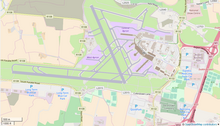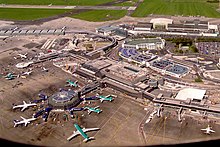Dublin Airport
| Dublin Airport Dublin Airport Aerfort Bhaile Átha Cliath |
|
|---|---|

|
|
| Characteristics | |
| ICAO code | EIDW |
| IATA code | YOU B |
| Coordinates | |
| Height above MSL | 74 m (243 ft ) |
| Transport links | |
| Distance from the city center | 10 km north of Dublin |
| Street | M1 / M50 |
| Local transport | bus |
| Basic data | |
| opening | January 19, 1940 |
| operator | Dublin Airport Authority |
| Terminals | 2 |
| Passengers | 32,911,227 (2019) |
| Air freight | 133,229 t (2019) |
| Flight movements |
238,998 (2019) |
| Capacity ( PAX per year) |
35 million |
| Runways | |
| 10/28 | 2637 m × 45 m concrete |
| 11/29
(closed) |
1339 m × 61 m asphalt |
| 16/34 | 2072 m × 61 m asphalt |
| 23
(closed) |
|
The Dublin Airport ( IATA : DUB , ICAO : EIDW ; English Dublin Airport , irish Aerfort Bhaile Átha Cliath ) is the international passenger airport to the Irish capital Dublin . It is the largest airport in the country and one of the 20 largest airports in Europe with around 30 million passengers per year and serves as the home base for the airlines Aer Lingus , Norwegian Air International , Ryanair and CityJet .
history
Dublin Airport opened in 1940. Dublin Airport experienced rapid growth and had passed the 23.4 million passenger mark with an annual growth of 15% by 2008 before the recession towards the end of the decade also caused problems for the expansion of the airport. Nevertheless, the new Terminal T2 , which was built for € 600 million, was opened in November 2010 . This means that the airport has a theoretical total capacity of 35 million passengers a year. In 2015, with 25 million passengers, the number from before the financial crisis was exceeded again for the first time.
In 2016, construction began on a new, 3,110 meter long runway in the north of the airport. Approx. 1,700 meters away, it will run parallel to the current, 2,637-meter-long main runway 10/28 and replace the now closed runway 11/29 , which was recently used to park aircraft . The opening is planned for 2021.
Location and transport links
The airport is about ten kilometers north of the city center on the M1 to Belfast .
Dublin city center can be reached by bus with the “Airlink” (lines 747 and 757) from Dublin Bus (approx. 25 min., € 7 or € 12 for a return trip) and lines 16, 16a, 41, 102 from Dublin Bus (approx. 40–60 min., Approx. 3 €, depending on the time of day).
The “Aircoach” express bus connects the airport with the city center in around 30 minutes. (€ 8 or € 13 return trip) and also connects the southern districts of Leopardstown and Donnybrook as well as the cities of Greystones , Killiney , Limerick and Cork .
A taxi to the center takes around 30 minutes (around € 30). (All prices as of summer 2010.)
Other places in Ireland can be reached by the Bus Éireann company .
In future, the airport is to be connected to Dublin city center via a planned subway route of the MetroLink project.
Airport facilities
Terminals
Dublin Airport has two terminals for passenger handling.
Terminal 1 - Piers A, B and D
Terminal 1 consists of three parts of the building known as piers. Pier A is the oldest and largest area, while Pier B is a smaller wing northwest of it. Pier C, which was only opened in 1999 and east of Pier A, had to give way to the construction of the new Terminal 2. Pier D to the north of Pier B is the latest addition from 2004 and is specially tailored to the needs of low-cost airlines such as Ryanair, which is based here. A large part of the airlines operating to and from Dublin are currently handled in Terminal 1, including the members of the Star Alliance , some of which will be gradually moved to the new Terminal 2.
Terminal 2 - Pier E.
In November 2010, the new Terminal 2, also known as Pier E, opened to the east of the existing facilities. The 600 million euro building has an area of 75,000 m² and 19 passenger boarding bridges and can handle up to 15 million passengers a year. Terminal 2 serves as the new home base of Aer Lingus and also handles all flights to North America and the United Arab Emirates .
Airlines and Destinations
Dublin has numerous connections to regional, European and some North American destinations, including Manchester , Copenhagen , Rome , Rhodes , Chicago and Toronto .
| rank | Airport | Passengers | ||
|---|---|---|---|---|
| 1 |
|
1,856,475 | ||
| 2 |
|
1,348,342 | ||
| 3 |
|
1,216,326 | ||
| 4th |
|
1.004.212 | ||
| 5 |
|
947.507 | ||
| 6th |
|
907.220 | ||
| 7th |
|
761.819 | ||
| 8th |
|
760.333 | ||
| 9 |
|
666.776 | ||
| 10 |
|
657,700 | ||
| Source: Central Statistics Office (Ireland) | ||||
Traffic figures

| year | Passenger volume | Air freight ( tons ) | Flight movements | |||
|---|---|---|---|---|---|---|
| National | International | transit | total | |||
| 2019 | 103,896 | 32,572,741 | 234,590 | 32,911,227 | 133.229 | 238.998 |
| 2018 | 111,850 | 31.146.011 | 237.743 | 31,495,604 | 143,708 | 233.185 |
| 2017 | 94.276 | 29,285,415 | 202.617 | 29,582,308 | 144.913 | 223.197 |
| 2016 | 93,731 | 27,641,025 | 172,628 | 27.907.384 | 134.207 | 215.078 |
| 2015 | 80,079 | 24,869,307 | 99,933 | 25,049,319 | 137.267 | 197,870 |
| 2014 | 70,795 | 21,636,533 | 4,639 | 21,711,967 | 127,448 | 180.334 |
| 2013 | 65,392 | 20.093.635 | 7,756 | 20.166.783 | 113,482 | 170.357 |
| 2012 | 60,572 | 19,031,776 | 7,301 | 19,099,649 | 111,100 | 163,670 |
| 2011 | 120,428 | 18,612,004 | 8,161 | 18,740,593 | 101,900 | 162.016 |
| 2010 | 369.010 | 18.052.312 | 9,742 | 18,431,064 | 105,300 | 160,320 |
| 2009 | 634.973 | 19,849,287 | 19,417 | 20,503,677 | 97,300 | 176.811 |
| 2008 | 844,594 | 22,557,426 | 64,691 | 23,466,711 | 107,300 | 211,890 |
| 2007 | 885.233 | 22,338,441 | 63,764 | 23,287,438 | 111,000 | 211,804 |
| 2006 | 813.177 | 20.274.309 | 108,896 | 21,196,382 | 107,200 | 196,641 |
| 2005 | 652.733 | 17,697,009 | 100,697 | 18,450,439 | 64,100 | 186,838 |
| 2004 | 690.205 | 16,372,011 | 76.157 | 17.138.373 | - | 182.175 |
| 2003 | 675,662 | 15,095,515 | 84.907 | 15,856,084 | - | 177.781 |
| 2002 | 650.965 | 14,310,485 | 123.217 | 15,084,667 | - | 181,874 |
| 2001 | 656.834 | 13,547,305 | 129,416 | 14,333,555 | - | 185,702 |
| 2000 | 661.062 | 13.030.426 | 152.040 | 13,843,528 | - | 180.245 |
| 1999 | 610.962 | 12,046,085 | 144.984 | 12,802,031 | - | 170.421 |
| 1998 | 539.444 | 10,978,094 | 123,562 | 11.641.100 | - | 162.086 |
Incidents
- On September 19, 1961, came with a 4 DC Douglas of the British Starways ( air vehicle registration G-ARJY) to a belly landing near the Dublin Airport. All 73 occupants survived, but the aircraft had to be scrapped.
- On June 12, 1967, a Bristol 170 Freighter Mk.31E of Aer Turas ( EI-APM ) coming from Prestwick Airport jumped up several times when landing at Dublin Airport, whereupon the pilots decided to take off. This led to the failure of the left engine and loss of control in a left turn. The left wing collided with an attic; it crashed. Both pilots, the only occupants, were killed.
- On 22 June 1967, a crashed Vickers Viscount 800 of Aer Lingus ( EI-AOF ) during a pilot training 15 km northwest of Dublin Airport. The machine crashed from a small height , presumably due to a stall . All three pilots on board were killed.
Web links
- Official website (English, Irish)
- Official website of the operator (English)
Individual evidence
- ↑ a b c d Our latest annual reports. DAA.ie , accessed on June 9, 2020 (English).
- ↑ a b c Aviation Statistics. CSO.ie , accessed June 9, 2020 .
- ↑ Dublin Airport Runway Specification
- ^ A b The Irish Times : Dublin airport's T2 unveiled , November 19, 2010
- ↑ Growing passenger numbers at Dublin Airport make future delays a hot topic
- ↑ pages of information about the project North Runway (English) on dublinairport.com, accessed on March 4, 2018
- ↑ Aircoach Fares ( Memento from April 21, 2011 in the Internet Archive )
- ↑ Websites of the MetroLink project (English) , metrolink.ie, accessed on June 9, 2019.
- ^ Accident report DC-4 G-ARJY , Aviation Safety Network (English), accessed on July 9, 2017.
- ↑ Aircraft accident data and report Bristol 170 EI-APM in the Aviation Safety Network , accessed on July 11, 2017.
- ↑ Aircraft accident data and report Viscount EI-AOF in the Aviation Safety Network (English), accessed on March 14, 2012.


